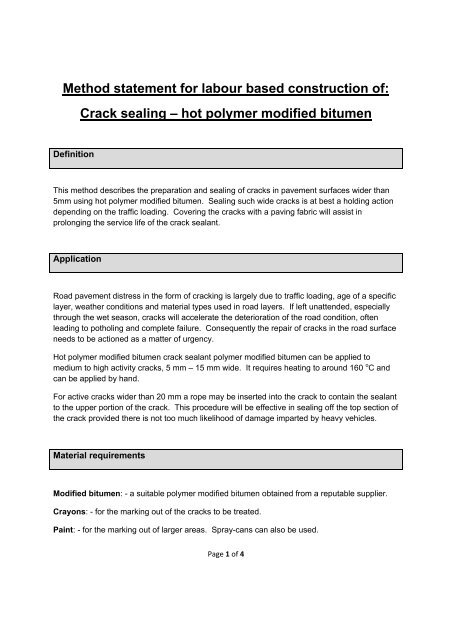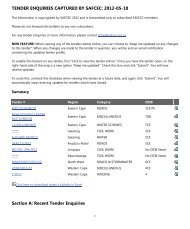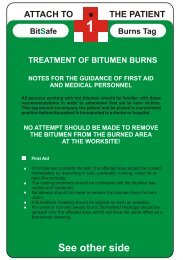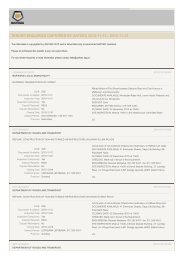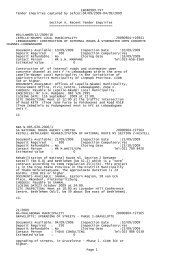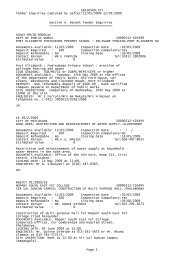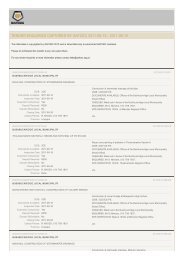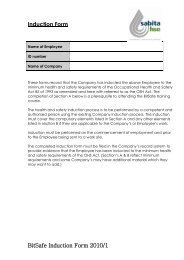Crack sealing - Sabita
Crack sealing - Sabita
Crack sealing - Sabita
You also want an ePaper? Increase the reach of your titles
YUMPU automatically turns print PDFs into web optimized ePapers that Google loves.
Method statement for labour based construction of:<br />
<strong>Crack</strong> <strong>sealing</strong> – hot polymer modified bitumen<br />
Definition<br />
This method describes the preparation and <strong>sealing</strong> of cracks in pavement surfaces wider than<br />
5mm using hot polymer modified bitumen. Sealing such wide cracks is at best a holding action<br />
depending on the traffic loading. Covering the cracks with a paving fabric will assist in<br />
prolonging the service life of the crack sealant.<br />
Application<br />
Road pavement distress in the form of cracking is largely due to traffic loading, age of a specific<br />
layer, weather conditions and material types used in road layers. If left unattended, especially<br />
through the wet season, cracks will accelerate the deterioration of the road condition, often<br />
leading to potholing and complete failure. Consequently the repair of cracks in the road surface<br />
needs to be actioned as a matter of urgency.<br />
Hot polymer modified bitumen crack sealant polymer modified bitumen can be applied to<br />
medium to high activity cracks, 5 mm – 15 mm wide. It requires heating to around 160 o C and<br />
can be applied by hand.<br />
For active cracks wider than 20 mm a rope may be inserted into the crack to contain the sealant<br />
to the upper portion of the crack. This procedure will be effective in <strong>sealing</strong> off the top section of<br />
the crack provided there is not too much likelihood of damage imparted by heavy vehicles.<br />
Material requirements<br />
Modified bitumen: - a suitable polymer modified bitumen obtained from a reputable supplier.<br />
Crayons: - for the marking out of the cracks to be treated.<br />
Paint: - for the marking out of larger areas. Spray-cans can also be used.<br />
Page 1 of 4
Plant and equipment requirements<br />
Item<br />
Heating device<br />
Wheel barrows<br />
Wire brushes<br />
Soft bristle brushes<br />
Block brushes<br />
Bass brooms<br />
Squeegees<br />
Safety gloves<br />
Cans or applicators<br />
Compressor<br />
Number of items<br />
1<br />
2<br />
2<br />
2<br />
2<br />
2<br />
2<br />
2<br />
2<br />
1<br />
Labour requirements<br />
Below is the typical composition of a crack <strong>sealing</strong> team. Production rates are very difficult to<br />
determine due to the many factors that could affect the process.<br />
Activity<br />
Supervisor<br />
General assistants<br />
Number of workers<br />
1<br />
8<br />
Traffic control personnel will need to be added to these numbers for a complete team<br />
complement. The amount of flagmen, stop/go boards and cones or delineators will be<br />
determined by the extent on the area to be repaired.<br />
Page 2 of 4
Construction<br />
Site Preparation<br />
The area to be repaired should be inspected together with the client or his agent and all the<br />
cracks that require <strong>sealing</strong> should be marked using the paint and the soft bristle, canyons Of<br />
spray cans of paint.<br />
The road needs to be swept clean of all loose material and dust. The wire brush should be<br />
used to loosen the material that is lodged in the cracks. This material needs to be swept out<br />
and away from the crack. Next the compressor should be used to blow the cracks clean of all<br />
dust and debris to ensure the sealant can adhere to both sides of the crack. Notice should be<br />
taken of the wind direction so as not to have the dust blown back into the cracks.<br />
Sealing of cracks<br />
The polymer modified bitumen should be heated in a safe manner to the required temperature<br />
of 160 o C. The heated polymer modified bitumen is then transferred to a specialised applicator<br />
or into a pouring can.<br />
Pour the sealant into the cracks from the can or applicator that should have a spout to help<br />
direct the bitumen into the crack. Ensure that the bitumen if fluid enough to penetrate into the<br />
crack and not just lie on the surface. Allow the polymer modified bitumen to harden.<br />
Using a hot scraper, spatula or spade excess material, protruding the crack, should be removed<br />
Traffic control<br />
The road can be opened to traffic as soon as the polymer modified bitumen has hardened<br />
sufficiently.<br />
Packing up and cleaning of equipment<br />
The signage can be moved to the next section of road to be repaired once the polymer<br />
modified bitumen has hardened.<br />
The tools should be cleaned with mineral turpentine or paraffin.<br />
.Quality control<br />
Page 3 of 4
If deemed necessary, weed killer should be applied to the cracks before applying the polymer<br />
modified bitumen.<br />
There should be no deleterious material e.g. oil and other contaminants near the cracks that will<br />
adversely affect the performance of the sealant.<br />
The polymer modified bitumen should not be allowed to drip onto the road surface between<br />
cracks thereby contaminating the road surface.<br />
Before <strong>sealing</strong>, the cracks should be clean and free of dust. If not, the polymer modified<br />
bitumen will not be able to adhere to both sides of the crack, allowing moisture to penetrate the<br />
crack which will defeat the purpose of the operation.<br />
Page 4 of 4


